A presentation by T L Hurst
Revised: 16th Jan 2013
The simultaneity-time model is based on the evidence that the speed of light is constant in the rest frame of the equipment used to measure it. A thought experiment illustrates the effects of this, without making any assumptions as to its value in other frames of reference. This identifies the "velocity effect". The mathematical relationship is derived. This shows that the effect differs from the Lorentz transformation. Hence a different conceptual framework is proposed: simultaneity-time.
Simultaneity-time is conceptually based on Newtonian relativity, but is extended to accommodate the effects of the fixed and finite speed of light. It provides an explanation of how light behaves in a scenario that is otherwise Newtonian.
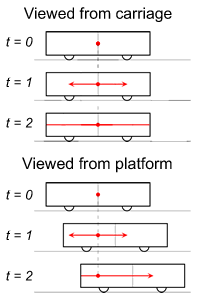
The idea that the speed of light, in empty space, is the same in all frames of reference is fundamental to Einstein's Special and General Theories of Relativity. Hence in the version of the Einstein's Train thought experiment given by Wikipedia [1] it is stated that the light approaching the ends of the carriage is travelling at c with respect to both:
This means that, for the observer on the train, the light flashes reach the ends of the carriage simultaneously, but for the observer on the platform, the light flashes reach the rear of the carriage first and the front later. This difference in simultaneity leads directly to the Lorentz transformation, and the time dilation and spatial contraction that describes.
However, the evidence provided by the Michelson's Interferometer experiment [2], and others like it, only show that measurements of the speed of light are constant in the rest frame of the equipment used to measure it. That says nothing about the speed that the light is travelling at with respect to other objects in different rest frames.
Hence the claim that the light is travelling at c with respect to the observer on the train follows from the empirical evidence, but the claim that it is the same with respect to the observer on the platform does not. Furthermore, the differences in simultaneity predicted by this have never actually been empirically observed. So this paper explores the implications of taking the speed of light to be constant in the rest frame of the target, i.e. without making any assumption as to its value in other frames of reference.
In a region of space far away from other material objects there is a radio transmitter and two girls, Alice and Betty. The transmitter emits a hundred time signals per second. At 10:00:00 the transmitter sends the time "10:00:00.00".
Alice and Betty each have a device capable of displaying the time signals as they are received. Each girl also has a synchronized clock co-located with them. Note: There is no time dilation in this scenario, so the clocks always indicate the same time as the transmitter. Betty is at rest with respect to the transmitter and 4 light seconds distant from it. So the time displayed on her device is always 4 seconds behind the actual time (as displayed on her clock).
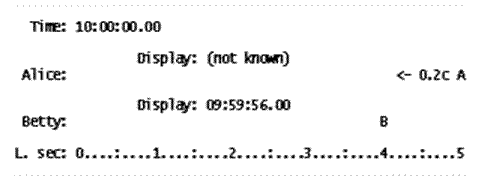
So at 10:00:00 Betty's device displays "09:59:56.00". Whilst at 10:00:00 Alice is 5 light seconds distant from the transmitter and approaching it at 0.2c (i.e. one fifth of the speed of light). At this moment, the time signal displayed on Alice's device is not known.
In 5 seconds time (at 10:00:05) Betty's device will display the time signal "10:00:01.00". Meanwhile, during the 5 seconds. Alice will have travelled 1 light second and be adjacent to Betty. You might therefore expect that at 10:00:05 she too would receive the time signal "10:00:01.00". However, in Alice's rest frame, she is stationary and the transmitter is approaching her at 0.2c. At 10:00:00, when it is 5 light seconds distant from her, the transmitter emits the time signal "10:00:00.00" and continues on its way. The time signal approaches her at the speed of light, so Alice will receive the time signal "10:00:00.00" at 10:00:05.
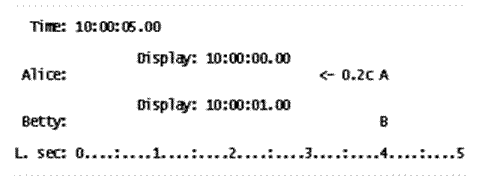
So at 10:00:05, even though they are adjacent, Betty receives the time signal "10:00:01.00" and Alice receives the time signal "10:00:00.00".
Furthermore, Alice, will see Betty's device displaying "10:00:01.00", and Betty will see Alice's device displaying "10:00:00.00". Also, as five seconds have passed since the time signal "10:00:00.00" was transmitted, both their clocks will display "10:00:05.00". So there is no discrepancy in how much time has actually passed for Alice and Betty (as indicated by their clocks), but the time signals received on adjacent devices from a distant transmitter differ by 1 second.
Let's now re-run the experiment, starting again at 10:00:00. This time, moments before they are adjacent, both girls move sideways such that at 10:00:05 each is at the exact position occupied by the other in the first experiment.
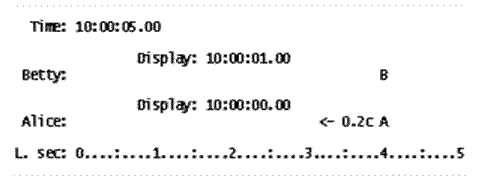
The small transverse movements should have no effect on when the girls receive the time signals, so Betty's device will still show "10:00:01" whilst Alice's will show "10:00:00". The girls are at the exact positions occupied by each other in the first run, yet each still receives the time signals according to their own relationship to the transmitter.
Similarly, we may add a third observer, Carol, who is travelling at 1/3 c away from the transmitter.
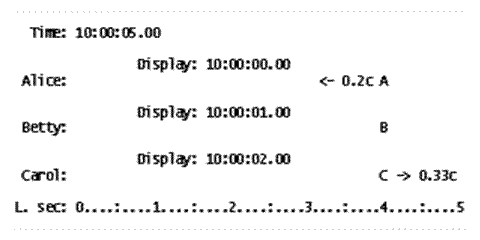
If at 10:00:02 Carol is 3 light seconds distant from the transmitter then, at 10:00:05 she too will be co-located with Alice and Betty, and her device will show "10:00:02.00".
Furthermore, if we assume that the girls could see the transmitter; at 10:00:05 Alice would see it as being 5 light seconds distant, Betty would see it as being 4 light seconds distant, and Carol would see it as being 3 light seconds distant. Is there an actual difference in the distance? No. The girls see the transmitter as being at different distances because they are seeing it where it was (with respect to themselves) when the light that each receives was emitted. So even though the actual physical relationships are unaffected, the apparent relationships to a distant object can, and will, differ.
It is apparent that, in the time taken for the time signal "10:00:00.00" to reach Alice, she "moves" 1 light second towards the transmitter, and that time signal is 1 second earlier than the one Betty receives (when they are adjacent). Whilst, in the time taken for the time signal "10:00:02.00" to reach Carol, she "moves" 1 light second away from the transmitter, and that time signal is 1 second later than the one Betty receives (when they are adjacent). This is so even though Alice travelled at 0.2c for 5 seconds, whilst Carol travelled at 0.33c for 3 seconds.
This suggests that:
This effect is referred to hereafter as the "velocity effect".
Note: You may have noticed that the Doppler effect has not been mentioned. The Doppler effect and the "velocity effect" are related, as, for light, both are products of the relative velocity of the source and the observer. However, the Doppler effect deals with the shift in frequency observed in the signals, whereas the "velocity effect" relates to the timing of the receipt of the signals.
The scenario we wish to model is where the speed of light is constant with respect to the target. The relationships between macro objects conform to Newtonian relativity. I.e. All motion is relative, and there is no time dilation or distance contraction.
The following diagram describes the scenario:
Note: For convenience, the graphic displays the scenario as viewed from the rest frame of the transmitter, and velocities are generally given with respect to the transmitter. However, it must be borne in mind that, in A's rest frame, he is stationary and the transmitter is moving away from him at velocity v.
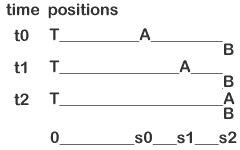
At time t0: A is a distance s0 from the transmitter, and is travelling away from it at velocity v. B is stationary with respect to the transmitter at a distance s2. In B's rest frame, the time signal "t0" is approaching him at the velocity c, such that he will receive the time signal "t0" at time t2.
At time t1: A is a distance s1 from the transmitter when the time signal "t1" is emitted. In A's rest frame, A is stationary and the time signal is approaching him at the velocity c, such that he will receive the "t1" time signal at time t2.
At time t2: A and B are adjacent, but A receives the time signal "t1", whilst B receives time signal "t0".
The idea of adjacent observers receiving different time signals from a distant transmitter/clock may seem illogical, even contradictory. Certainly, if we envisage space as a physical entity and light as particles or waves travelling through that space, it would be impossible. We present a conceptual resolution of this apparent contradiction below, but here we merely seek to quantify the phenomenon. So, we can say that the time taken for the t1 signal to reach A is t2 - t1. In that time, A moves s2 - s1 at velocity v (with respect to the transmitter). Therefore:
(t2 - t1) = (s2 - s1)/v
or
(s2 - s1) = v(t2 - t1)
We noted that:
This was referred to as the "velocity effect", which we shall denote with the symbol o. So:
o = (s2 - s1) = v(t2 - t1) (where s1 and s2 are measured in light seconds, and v is measured in light seconds per second). Or:
o = (s2 - s1)/c = v(t2 - t1)/c (where s1, s2 and v are is SI units).
The problem identiied in the Light Experiment is that, under this scenario, two or more observers can receive different time signals from a distant transmitter, even though they are adjacent at that moment. Furthermore, when the experiment is re-run and the observers swap places, they still receive the time signals related to their own relationship to the transmitter. If you regard space as a physical entity, and light as photons or waves travelling through that space, then this "velocity effect" is impossible. It simply could not happen. Furthermore, unlike the Lorentz transformation, the relationship is linear, This suggests that we need a different conceptual explanation of the phenomenon.
The scenario I wish to propose focuses on two classes of entities:
So how do we put together a conceptual framework that meets these criteria? Well, if material objects behave as if space exists as a physical entity, but light behaves as if it isn't, then it's as if there are two different universes that interact and affect one another. I say as if because I do not mean to imply that this is actually the case. Merely that it appears to be different to different types of entities. Hence the nature of the actual universe must support these two views.
Furthermore, if space does not exist as an absolute entity in the universe experienced by photons, then it cannot do so in the actual universe. But if that is so, what meaning can we attribute to spatial distances? Also, what causes the delay, from our perspective, between photons being emitted by one object and being absorbed by another?
One solution to this is to adapt an idea suggested by Einstein, that of differences in simultaneity. In his original paper on Special Relativity, Einstein said:
"So we see we cannot attach any absolute signification to the concept of simultaneity, but that two events which, viewed from a system of co-ordinates, are simultaneous, can no longer be looked on as simultaneous events when envisaged from a system which is in motion relatively to that system."
Einstein suggested that simultaneity was dependent on the frame of reference, and that two events which are simultaneous when seen from one frame of reference may not be so from a different frame of reference. Let's take this idea, but instead of attributing the effect to the relative motions of the frames of reference (which are, in themselves, no more than abstract concepts), let us assume that it is an inherent property of macro objects. The significance of this may not be immediately apparent, so let's put it another way...
Conventionally we would say that where an object is determines when it experiences events. But if space is not an absolute entity, what determines where an object is? It is undefined. So, instead, let us reverse this causal relationship and state that when an object experiences events determines where it is. Thus if we take the case of two objects mutually at rest, we may say that if there is a delay of five seconds between the emission of light by one body, and its reception by another, it is because there is five seconds difference in their view of when that event occurred. I.e. Their view of simultaneity differs by five seconds. So we may say that the objects are "five light seconds apart", which, using c, translates into a spatial distance of one and a half million kilometres (or thereabouts).
This suggests that spatial distances are the outward signs of underlying differences in simultaneity between objects. Also, the distance between two objects at the time that the light from one object is received by the other will appear to be the distance they were apart when the light was emitted. So for objects that are not mutually at rest, there is a difference between the actual distance between them and the apparent distance. The mathematical relationship for this phenomenon is given above.
For convenience we may refer to this conceptual framework as suggesting a simultaneity-time (or simtime) universe, but that is not to be interpreted as a physical entity. In this scenario, the "spatial" dimensions of the continuum are properties of the macro objects, which are not in space but rather define it. So space is a property of macro objects, and has no absolute existence.
It follows that, in this conceptual framework, c is not a velocity. Instead it is a universal constant that links a difference in simultaneity between two macro objects to the physical distance between them.
In this presentation of the simultaneity-time framework I have sought to show that it is possible to model the behaviour of light without invoking the Lorentz transformation. However, to accommodate the behaviour of light, the concept of space as a physical entity cannot be sustained. This leads to, but is not dependent on, the simultaneity-time scenario put forwards here. Simultaneity-time (or simtime) is conceptually based on Newtonian relativity, but is extended to accommodate the effects of the fixed and finite speed of light. It also provides an explanation of how light can behave in the manner it does in a scenario that is otherwise Newtonian, and the effect of the speed of light on the reception of light from a distant source has been illustrated.
This Presentation of the Simultaneity-Time Model of the Universe is available in PDF format.